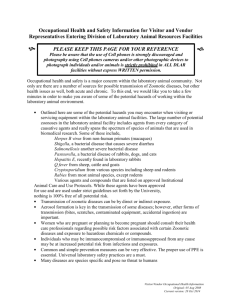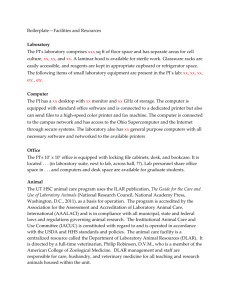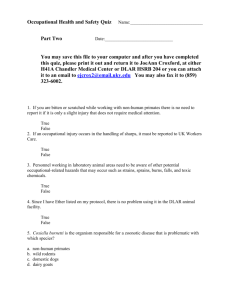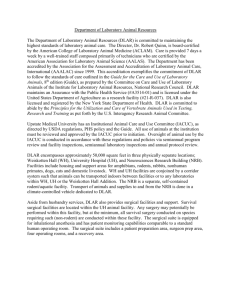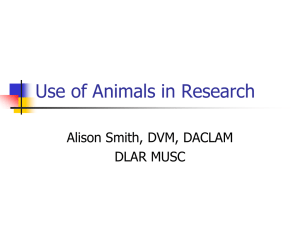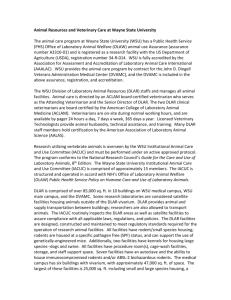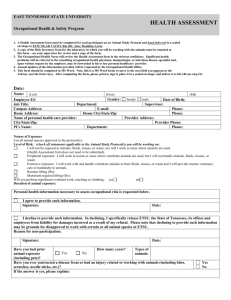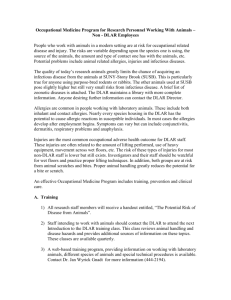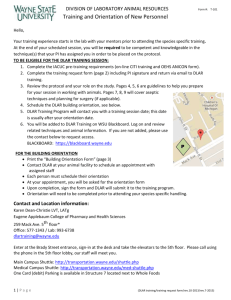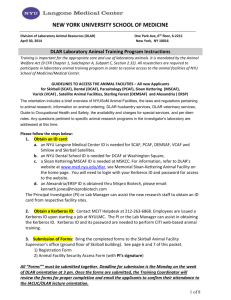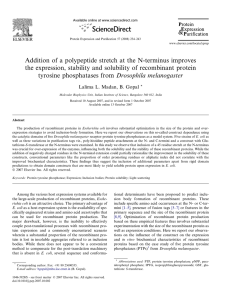Occupational health and safety are a major concern with
advertisement
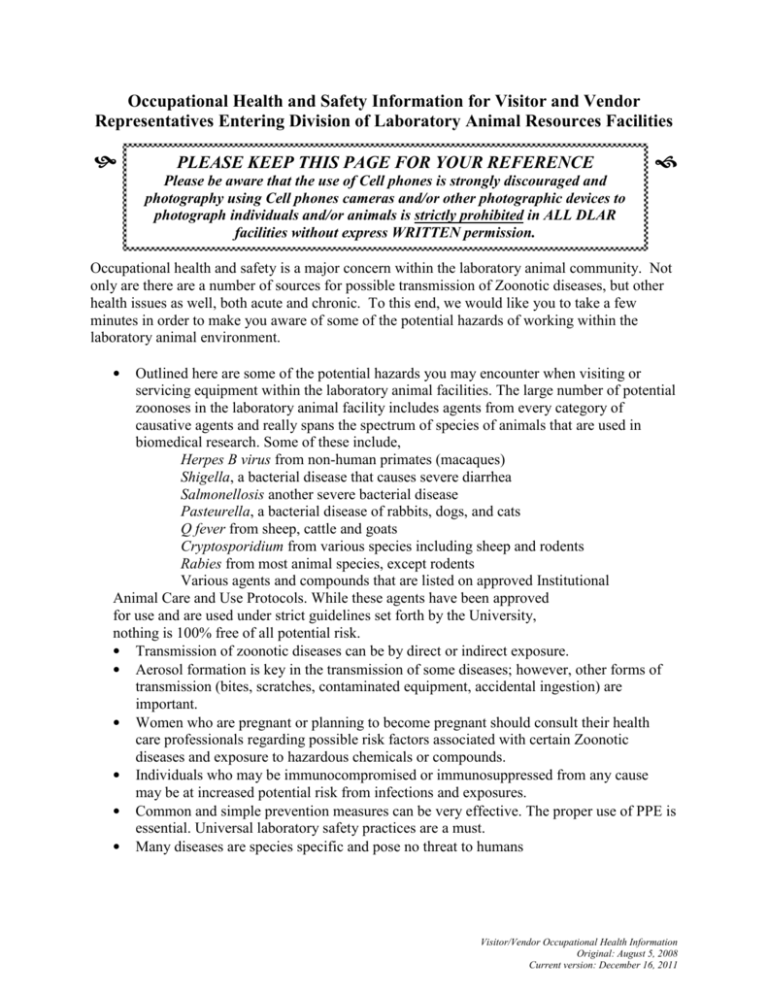
Occupational Health and Safety Information for Visitor and Vendor Representatives Entering Division of Laboratory Animal Resources Facilities PLEASE KEEP THIS PAGE FOR YOUR REFERENCE Please be aware that the use of Cell phones is strongly discouraged and photography using Cell phones cameras and/or other photographic devices to photograph individuals and/or animals is strictly prohibited in ALL DLAR facilities without express WRITTEN permission. Occupational health and safety is a major concern within the laboratory animal community. Not only are there are a number of sources for possible transmission of Zoonotic diseases, but other health issues as well, both acute and chronic. To this end, we would like you to take a few minutes in order to make you aware of some of the potential hazards of working within the laboratory animal environment. • Outlined here are some of the potential hazards you may encounter when visiting or servicing equipment within the laboratory animal facilities. The large number of potential zoonoses in the laboratory animal facility includes agents from every category of causative agents and really spans the spectrum of species of animals that are used in biomedical research. Some of these include, Herpes B virus from non-human primates (macaques) Shigella, a bacterial disease that causes severe diarrhea Salmonellosis another severe bacterial disease Pasteurella, a bacterial disease of rabbits, dogs, and cats Q fever from sheep, cattle and goats Cryptosporidium from various species including sheep and rodents Rabies from most animal species, except rodents Various agents and compounds that are listed on approved Institutional Animal Care and Use Protocols. While these agents have been approved for use and are used under strict guidelines set forth by the University, nothing is 100% free of all potential risk. • Transmission of zoonotic diseases can be by direct or indirect exposure. • Aerosol formation is key in the transmission of some diseases; however, other forms of transmission (bites, scratches, contaminated equipment, accidental ingestion) are important. • Women who are pregnant or planning to become pregnant should consult their health care professionals regarding possible risk factors associated with certain Zoonotic diseases and exposure to hazardous chemicals or compounds. • Individuals who may be immunocompromised or immunosuppressed from any cause may be at increased potential risk from infections and exposures. • Common and simple prevention measures can be very effective. The proper use of PPE is essential. Universal laboratory safety practices are a must. • Many diseases are species specific and pose no threat to humans Visitor/Vendor Occupational Health Information Original: August 5, 2008 Current version: December 16, 2011 • One of the most common occupational health issues is that of the potential to develop an allergic reaction or occupational allergy. The risk of developing a laboratory animal allergy is related to allergen exposure and individual immune system response. • Personnel with no history of allergic reactions are unlikely to develop laboratory animal allergies • Personnel with a history of allergic reactions are much more likely to develop laboratory animal allergies and the incidence increases with increasing exposure These risks may be presented by the animal itself, organisms harbored by the animal or hazardous agents used as part of the study protocol. Passive or incidental contact with tissues, body fluids, or clothing contaminated with dander, animal waste, or other contaminates may, also, present a risk for certain individuals. These risks, while very small, still have a potential for exposure. Always remember that prevention is the best approach. Prevention is very simple. Universal lab practices should be followed. Always wear personal protective equipment when servicing or calibrating equipment that has been used on animals. Even though all equipment is thoroughly cleaned and disinfected after each use, you should take precautions. Follow the standard operating procedures of your individual company when handling equipment in an animal facility. If you do not have a University of Kentucky identification badge with DLAR access, you must obtain a visitors pass in the main office HSRB 204 (859-3235885) and be escorted into the animal facility by a DLAR staff member. Do not eat or drink while working in the animal facility or laboratories. Wear appropriate personal protective equipment as recommended, masks, safety glasses or chemical goggles, disposable clothing, gloves, etc. Adhere to all safety regulations outlined in your company’s standard operating procedures Respect the rules of the facilities you are working in. Avoid prolonged exposure to waste gases without proper respirator equipment or scavenging systems when servicing anesthesia equipment. If you have questions or need assistance, please contact a supervisor or DLAR staff member. If your work takes you into another area of the facility, contact a supervisor prior to entry. Do not enter into any animal housing room or surgical area when an animal is present unless previously authorized by a DLAR veterinarian. Do not take pictures in any animal facility without written permission of DLAR management. Your health and safety is important to us. If you have questions, please contact the staff member you will be working with and they will be happy to assist you. You may also contact our Training Coordinator, JoeAnn Croxford, at (859)323-3616. ________________________________________ PLEASE KEEP THIS PAGE FOR YOUR REFERENCE Please be aware that use of Cell phones is strongly discouraged and photography using Cell phones cameras and/or other photographic devices to photograph individuals and/or animals is strictly prohibited in ALL DLAR facilities without express WRITTEN permission. Visitor/Vendor Occupational Health Information Original: August 5, 2008 Current version: December 16, 2011 Statement of receipt Occupational Health and Safety Information for Visitor and Vendor Representatives Entering Division of Laboratory Animal Resources Facilities I have received a copy of this information and have read its contents. * Print Name Legibly: ___________________________________ * Signed: ______________________________________ * Company: ______________________________________ * Date: ____________ * indicates required information For individuals who may be accessing areas where non-human primates may be present or housed: Please sign and date after the following declarations. “I have received a negative tuberculin skin test within the past year.” “ I have been vaccinated and/or have a confirmed titer for Rubeola (regular measles).” Signed:___________________________________________ Date: ____________ PLEASE RETURN THIS PAGE TO THE DLAR TRAINING COORDINATOR JOEANN CROXFORD H41A CHANDLER MEDICAL CENTER OR HSRB 204 Visitor/Vendor Occupational Health Information Original: August 5, 2008 Current version: December 16, 2011
